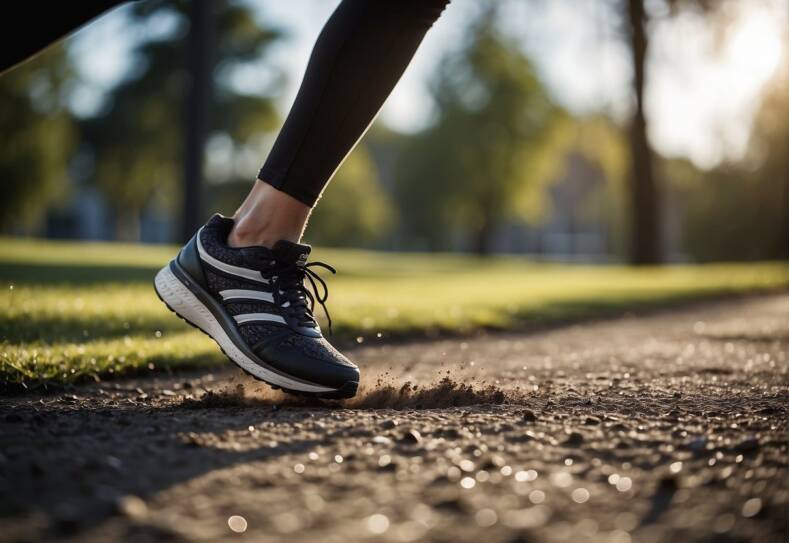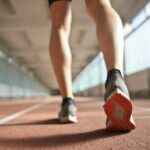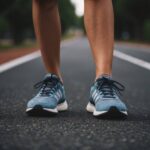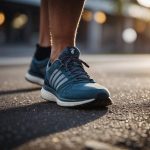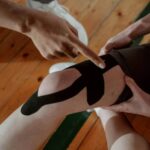When considering running form, one aspect that stands out is foot strike pattern, a term that describes the way a runner’s foot meets the ground with each step. The most common foot strike among runners is the heel strike, where the heel touches down before the rest of the foot. This method is observed in the majority of distance runners, both elite and recreational. Heel striking is preferred by many due to its perceived naturalness and the role of cushioned running shoes that support this style.
Running form varies from runner to runner, and along with heel striking, there are midfoot and forefoot striking patterns. Midfoot striking involves landing flat-footed, which can offer a balance between heel striking and forefoot striking, potentially lending benefits of both forms. Forefoot striking, on the other hand, involves landing on the balls of the feet. This pattern requires more calf strength and has been linked to higher efficiency in some runners. Each foot strike method carries its own set of advantages and potential risks for injury.
The ongoing debate in the running community regarding the optimal foot strike pattern points to the complexity of human biomechanics and individual variability. While some research suggests that non-heel strikers may have a lower risk of repetitive stress injuries, there is no one-size-fits-all answer. Factors such as a runner’s biomechanics, strength, flexibility, and personal comfort all influence their foot strike pattern. Consequently, it is important for runners to understand their own body and consider professional guidance when evaluating their running form.
Anatomy of a Runner’s Footstrike
A runner’s footstrike is the way the foot hits the ground during running. The anatomy of this motion is complex and varies between runners, often categorized by the initial point of contact: the heel, midfoot, or forefoot.
Heel Strike Mechanics
When a heel striker runs, the rearfoot or heel is the first part of the foot to make contact with the ground. This technique is characterized by an initial ground contact mid-to-back of the foot, followed by a roll forward onto the middle and then balls of the feet. Despite its prevalence among runners, some studies suggest that excessive heel striking may lead to higher impact forces, potentially increasing injury risk.
Midfoot and Forefoot Strike Characteristics
Midfoot striking involves landing flat-footed, where the midsole makes contact simultaneously with the running surface. This style distributes impact more evenly across the foot. Conversely, forefoot running or forefoot striking describes a landing on the balls of the feet, just behind the toes. It allows a runner to capitalize on the natural spring mechanism of the foot’s arch. Forefoot runners often have a shorter stride and higher cadence, potentially reducing impact stress on the legs.
The Role of Ankle and Foot in Running
During running, the ankle and foot work collaboratively to absorb impact, stabilize the body, and propel the runner forward. The proper running foot strike optimizes these functions, aiming for a quick, light touch and rapid movement off the ground. The anatomy and mechanics of the footstrike play a significant role in overall running efficiency, influencing the load on lower extremity joints and soft tissues, thus affecting a runner’s speed and endurance.
Biomechanics and Running Efficiency
Considering the mechanics of running, efficiency often becomes a central discussion point, where the type of footstrike has been observed to play a significant role. This section dives into how varying footstrikes, including heel striking and midfoot striking, contribute to the overall energy expenditure and running economy, as well as their impact on an athlete’s stride and cadence.
Energy Expenditure in Different Footstrikes
Different footstrike patterns can influence the amount of energy a runner uses. Heel striking is characterized by the runner’s heel making the initial contact with the ground. It is associated with a braking force that can potentially lead to a higher energy expenditure per stride.
- Heel Striking: May lead to increased energy use due to:
- Greater impact forces
- Possible overstriding
- Midfoot Striking: Often deemed more efficient since:
- It can reduce the braking effect
- Tends to align with the center of mass on landing
Regarding running efficiency, it’s the relationship between the energy consumed and the distance covered, with an efficient runner using less energy to cover the same distance. A switch from heel striking to midfoot striking has the potential to reduce energy expenditure, though individual biomechanics and comfort levels can result in variances in efficiency.
Stride and Turnover Relevance
Stride mechanics, including the length and rate of each step, are integral to a runner’s performance. Cadence, or turnover, is the number of steps a runner takes per minute, and with heel striking, there might be a tendency to have a lower cadence with longer stride lengths. Running cadence has been linked to efficiency, with a higher step rate sometimes correlating to improved running economy.
- Heel Striking: May lead to a lower cadence and longer strides, which, while covering more ground per step, could potentially reduce overall efficiency.
- Midfoot Striking: Often encourages a higher cadence with shorter, quicker steps, which may contribute to an improved running economy.
The biomechanics of each footstrike pattern influences the energy demand on the runner. While running speed and running cadence are personal elements tailored to the individual athlete’s body, studying and adjusting one’s footstrike may offer paths to enhance running efficiency.
Health and Injury Considerations
The incidence of injury in runners often correlates with their foot strike patterns. Understanding these correlations and preventive practices is critical for sustained running health.
Comparing Injury Risks Among Striking Patterns
Heel striking during running is notable for its association with specific types of injuries when compared with midfoot or forefoot striking. Heel strikers are more prone to experience knee pain and complications in the hip area due to the increased impact forces traveling up the leg. In contrast, runners who employ forefoot or midfoot striking patterns may encounter higher stress on the Achilles tendon and calf muscles, potentially leading to different types of injuries such as calf strains or Achilles tendinopathy.
While some studies suggest that heel striking might increase the possibility of running injuries, it is essential to consider individual variance among runners. For example, overstriding, a common issue with heel strikers, can amplify injury risk by increasing the braking force with each foot strike, potentially leading to shin splints or stress fractures.
Preventing Common Running Injuries
To prevent running-related injuries, it is advisable for runners to focus on a few key areas:
- Addressing muscle imbalance through targeted strength training can aid in stabilizing the running gait and reducing undue stress on certain muscle groups.
- Injury prevention routines should include exercises that enhance flexibility and strength, particularly in the lower extremities.
- Mindful running, ensuring not to overstride, can aid in reducing the risk of injuries.
Adopting these and other preventive measures can help runners mitigate the heightened injury risk associated with various foot strike patterns, ensuring a safer, more sustainable running practice.
Training Techniques for Optimal Striking
To achieve optimal heel striking in running, one can adopt specific drills, strengthening, and flexibility routines tailored to improve technique and lower limb conditioning. This approach aims to enhance the footstrike for better running efficiency and injury prevention.
Drills to Improve Heel Striking
Drills are fundamental for reinforcing proper running mechanics and developing an efficient heel strike. These exercises are designed to improve timing, spatial awareness, and muscle memory:
- Skipping Drills: They promote rhythm and coordination, which are essential for a consistent heel-to-toe transition.
- Heel Walks: These improve the strength and endurance of the shin muscles, which play a crucial role in a proper heel strike.
Strength and Flexibility for Better Footstrikes
Strength and flexibility directly impact running form. A focus on lower-body strength, particularly in the glutes and hamstrings, can support a runner’s ability to maintain proper form over distance:
- Glute Bridges: Strengthen the glute muscles, facilitating a stable pelvis during running.
- Dynamic Stretching: Incorporating leg swings and lunges can improve hip and hamstring flexibility, allowing for a fuller range of motion.
Calf and Toe Exercises for Runners
Calf strength is vital for the push-off phase of running, while flexible toes facilitate a smoother transition from heel to toe. These exercises enhance control and power of the footstrike:
- Calf Raises: Strengthen the calf muscles, crucial for the push-off phase and to absorb shock during heel strike.
- Toe Curls: These improve toe flexibility and strength, which contribute to the final push-off from the ground.
By integrating these exercises into their training, runners can work towards a more efficient and effective heel-striking pattern.
The Influence of Footwear on Strike Patterns
The shoes a runner chooses directly impact their foot strike pattern during running. Factors like cushioning and shoe design play pivotal roles in the biomechanics of running gait, affecting impact forces on the joints and overall running efficiency.
Choosing the Right Running Shoes
Choosing the right running shoes is a critical decision for runners seeking to improve performance and minimize injury risk. Running shoes are designed with various levels of cushioning and structural features that can influence a runner’s gait. Individuals should consider their unique foot anatomy, preferred distance, and running surface when selecting footwear that supports their natural strike pattern.
Impact of Cushioning on Running Gait
The degree of cushioning in running shoes affects the runner’s impact forces and gait. Shoes with substantial cushioning can encourage a heel strike pattern, as the added material under the heel absorbs impact, which could be more comfortable for long-distance runners. Studies suggest that increased cushioning may alter the initial point of contact, affecting the kinetics of the run.
Minimalist and Barefoot Running Trends
The trends of minimalist and barefoot running have highlighted the importance of natural gait with minimal interference from footwear. Runners who adopt these styles often adjust to a forefoot or midfoot strike pattern, reflecting the natural mechanics observed in barefoot running. This running style is argued to decrease impact forces and potentially reduce the likelihood of certain injuries. However, making the transition to minimalist or barefoot running should be approached cautiously, with gait analysis to ensure compatibility with the individual’s biomechanics.
Running Form and Style Variations
Optimal running form can significantly affect a runner’s speed and endurance. It encompasses how the feet strike the ground, limb alignment, and body posture. Runners may adjust their style for efficiency and to meet the physical demands of different distances.
Adapting Running Style for Speed and Distance
In the quest for speed, a runner’s form is often adapted to maximize energy efficiency and propulsion. Sprinters may use a forefoot strike to maintain rapid turnover and powerful forward momentum, while distance runners may benefit more from a midfoot or heel strike to conserve energy over time. The running stride of a sprinter is characteristically shorter and quicker, which promotes faster acceleration.
- Elite sprinters often display:
- A shorter contact time with the ground.
- Higher knee and hip drive.
- A pronounced forward lean of the torso.
By contrast, endurance runners emphasize a steady, rhythmic cadence and greater attention to the conservation of energy. Their alignment and stride are oriented towards sustaining effort with a key focus on:
- Minimizing vertical oscillation.
- Maintaining a steady center of gravity.
- Ensuring proper joint alignment to reduce the risk of injury.
Kinetics of Marathon Runners vs Sprinters
Marathon runners and sprinters exhibit distinct kinetic patterns due to the various demands of their events. Marathon runners must manage their energy over longer distances, often leading to a running form that maximizes endurance and minimizes fatigue. They tend to strike with the heel first which facilitates a smoother transition of weight and less peak loading on the calves and knees.
- Kinetics observed in marathon runners include:
- A generally more upright posture.
- Reduced hip and knee flexion to facilitate longer steps.
- A focus on forward propulsion through increased ground contact time.
Sprinters, alternatively, require immediate, explosive force and thus emphasize a powerful push-off with each stride to maximize speed. They demonstrate a greater range of motion at the hip and knee to facilitate higher acceleration, and their calves are heavily engaged to produce rapid, forceful movements.
- Characteristics of a sprinter’s form:
- High knee lift and forceful leg extension.
- A greater forward lean to increase stride length and speed.
- More aggressive arm swing to balance the powerful leg action.
Running style is not one-size-fits-all, and proper form is often a balance between personal biomechanics and the goals of the runner, whether they’re chasing speed or endurance.
Advancement and Running Research
Recent advancements in running research have significantly enhanced understanding and assessment capabilities related to running biomechanics, particularly the gait cycle and foot strike patterns. These developments impact the advice and strategies provided by running coaches and physical therapists aimed at improving runners’ efficiency and reducing injury risks.
Insights from Gait Cycle Analysis
Researchers have emphasized the importance of analyzing the running gait cycle to identify biomechanical inefficiencies and injury-prone motions. The gait cycle’s phases, including heel strike and toe-off, are scrutinized to understand the stress placed on the knee and ankle joints. Studies have shown the correlation between the foot strike technique, such as rearfoot strike (RFS), and the incidence of running-related injuries. This understanding allows for targeted interventions to enhance gait efficiency and reduce joint stress.
- Impact on Knee: A runner’s knee experiences varying levels of stress depending on their foot strike patterns. Research suggests an increased knee loading with a heel-first impact compared to a forefoot strike.
- Ankle Mobility and Stiffness: Ankle stiffness and mobility are critical during the gait cycle. Adequate ankle flexibility allows for a smoother transition from heel strike to toe-off, influencing running cadence and the risk of injury.
Emerging Technologies in Running Assessment
Advances in technology have introduced tools like pressure-sensitive treadmills, wearable sensors, and motion capture systems that provide a detailed analysis of a runner’s mechanics.
- Pressure-sensitive Treadmills: These tools measure the forces exerted at different points of the foot during the gait cycle, enabling researchers and clinicians to understand the distribution of impact.
- Wearable Sensors: Wearable sensors track detailed biomechanical data while runners are in motion, offering real-time feedback that could help in making immediate corrections to running form for energy efficiency and injury prevention.
- Motion Capture Systems: Such systems offer three-dimensional analysis of running gait, helping to pinpoint deviations in mechanics that might lead to injury or inefficiency.
The continuous development of these assessment technologies represents a quantum leap forward in the field, providing running coaches and physical therapists with invaluable resources to help runners achieve optimal performance safely.
The Cultural Impact of Running Techniques
Running techniques, particularly heel striking, have stirred vibrant discussions within running communities and on social media platforms. These conversations not only reflect current preferences and practices but also tie back to historical perspectives, all of which shape the running culture as we know it today.
Running Communities and Social Media Discussions
In running communities, both online and offline, the topic of heel striking versus other foot strikes spurs ongoing debate. On social media platforms like Twitter and Instagram, runners share slow-motion videos capturing their stride, seeking advice and validation on their technique. Running forums and Facebook groups are inundated with posts discussing the merits of various foot strikes, with many experienced runners sharing their personal experiences and the adjustments they’ve made. These platforms have become a bastion for community support, where newcomers can learn from seasoned veterans, fostering a sense of unity and common identity among runners.
Historical Perspectives and Born to Run
Historically, the publication of the book “Born to Run” by Christopher McDougall sparked a significant shift in how runners view foot striking. The book played a substantial role in popularizing the barefoot running movement and the preference for a midfoot or forefoot strike. It asserted that modern running shoes contribute to poor technique and increased injury rates – a claim that resonated with many in the running community and led to widespread discussions about the naturalistic aspects of running form. This contribution to historical interest in running techniques underscores the book’s influence, as runners continue to reference it in conversations about the evolution of running form over the years.
